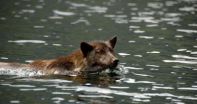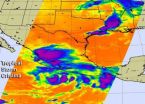(Press-News.org) New research co-authored by University of Calgary alumna Erin Navid provides evidence that British Columbia's mainland wolves and coastal wolves are more distinct than previously believed.
The research, published today in the scientific journal BMC Ecology, affirms what Chester Starr, an elder from the Heiltsuk First Nation on BC's remote west coast, and his people have always known: 'Timber Wolves' occupy the mainland of the British Columbia coast and 'Coastal Wolves' live on the nearby islands. Starr's insight provided motivation for the study.
"What makes this study special is the fact that differentiation is not supposed to occur on such a small-scale," says Navid, who graduated from the Faculty of Environmental Design, Environmental Science Program in 2009. "Wolves are highly mobile animals, capable of crossing many types of natural barriers, including small bodies of water. We did not expect to uncover a genetic gradient in an area that is only 2,000 square kilometres and relatively permeable to wolf movement."
The authors attribute the observed genetic differentiation to the profoundly different ecological environments. Coastal islands offer wolves more marine-based foods, such as salmon and marine mammals—preferences that are passed on from generation to generation. Over time, coastal wolves bred more frequently with one another and less frequently with their deer-loving relatives on the mainland.
Navid analyzed DNA samples from wolf scats collected in the field as part of her masters' thesis in the Faculty of Environmental Design.
The discovery also emphasizes the importance of incorporating traditional ecological perspectives with empirical scientific methods. "An emerging mutual recognition is that although indigenous and scientific approaches constitute different paths to knowledge, they are rooted in the same reality and provide complementary information," says co-author Paul Paquet, an adjunct professor at the University of Calgary.
These approaches are useful in addressing today's conservation challenges and opportunities. In this particular study, efforts at landscape conservation can be informed by detailed information about the habits of animals across space.
INFORMATION:
The study is available at BMC Ecology 2014, 14:11 doi:10.1186/1472-6785-14-11
http://www.biomedcentral.com/1472-6785/14/11
Wolves in wolves' clothing not all the same
University of Calgary researchers reveal surprising genetic differences among wolves in coastal British Columbia
2014-06-10
ELSE PRESS RELEASES FROM THIS DATE:
Coho salmon: Pinks' and chums' eating cousin
2014-06-10
Newly published research co-authored by scientists at Simon Fraser University and the Raincoast Conservation Foundation shows juvenile coho salmon benefit from dining on the distant remains of their spawning pink and chum cousins.
While juvenile coho salmon feed directly on spawning pink and chum salmon carcasses and eggs, even coho with no direct contact with spawning pink and chum benefit from their nutrient contributions to stream ecosystems.
The new research shows that juvenile coho abundance is up to three times higher in streams with abundant pink and chum compared ...
Genetics reveal that reef corals and their algae live together but evolve independently
2014-06-10
New research reveals that Caribbean corals and the algae that inhabit them form a remarkably stable relationship -- new knowledge that can serve as an important tool in preserving and restoring vital reef-building corals. A scientific paper describing these new findings by a team of marine biologists at Penn State University will be published as a cover article in Molecular Ecology on 10 June 2014.
Coral reefs are important for protecting shorelines, providing seafood, and generating millions of dollars in recreation revenue each year, but rising water temperatures due ...
Miriam Hospital study shows how to make statewide health campaigns more effective
2014-06-10
PROVIDENCE, R.I. - Researchers from The Miriam Hospital have found that adding evidence-based weight loss strategies to a statewide wellness campaign improves weight loss outcomes among participants. The study and its findings are published online in advance of print in the American Journal of Public Health.
Lead researcher Tricia Leahey, Ph.D., and her colleagues chose to conduct a study among participants in Rhode Island's annual, three-month statewide health campaign. Called Shape Up Rhode Island (SURI), the campaign was founded in 2005 and takes a grass roots approach ...
NASA sees Tropical Storm Christina's birth and severe weather in US South
2014-06-10
NASA's Aqua satellite captured a picture of newborn Tropical Storm Cristina on June 10, marking the birth date of the Eastern Pacific Ocean's third tropical storm of the season. The same image showed the severe weather affecting the south central U.S.
Although not at the coastline, the National Hurricane Center said that Cristina is near enough to cause dangerous surf conditions.
According to the National Hurricane Center (NHC), swells generated by Cristina are affecting portions of the south-central coast of western Mexico. These swells will likely continue through ...
NASA-NOAA's Suomi NPP satellite spots Arabian Sea tropical cyclone
2014-06-10
Tropical Cyclone 02A formed in the Arabian Sea as NASA-NOAA's Suomi NPP satellite passed overhead and captured a visible photo of the storm, spotting strongest storms south of its center.
On June 10 at 08:21 UTC (4:21 a.m. EDT), when Suomi NPP passed over 02A, the Visible Infrared Imaging Radiometer Suite (VIIRS) instrument aboard captured a visible image of the storm. VIIRS collects visible and infrared imagery and global observations of land, atmosphere, cryosphere and oceans.
In the image, Tropical Storm 02A appeared slightly elongated but satellite data shows that ...
NASA's SDO sees a summer solar flare
2014-06-10
The sun emitted a significant solar flare, peaking at 7:42 a.m. EDT on June 10, 2014. NASA's Solar Dynamics Observatory – which typically observes the entire sun 24 hours a day -- captured images of the flare.
Solar flares are powerful bursts of radiation. Harmful radiation from a flare cannot pass through Earth's atmosphere to physically affect humans on the ground. However, when intense enough, they can disturb the atmosphere in the layer where GPS and communications signals travel.
To see how this event may affect Earth, please visit NOAA's Space Weather Prediction ...
Inside the adult ADHD brain
2014-06-10
CAMBRIDGE, MA -- About 11 percent of school-age children in the United States have been diagnosed with attention deficit hyperactivity disorder (ADHD). While many of these children eventually "outgrow" the disorder, some carry their difficulties into adulthood: About 10 million American adults are currently diagnosed with ADHD.
In the first study to compare patterns of brain activity in adults who recovered from childhood ADHD and those who did not, MIT neuroscientists have discovered key differences in a brain communication network that is active when the brain is at ...
Mammography has led to fewer late-stage breast cancers, U-M study finds
2014-06-10
ANN ARBOR, Mich. — In the last 30 years, since mammography was introduced, late-stage breast cancer incidence has decreased by 37 percent, a new study from the University of Michigan Comprehensive Cancer Center finds.
The analysis takes into account an observed underlying trend of increased breast cancer incidence present since the 1940s, a sort of inflation rate for breast cancer.
Researchers looked at early-stage and late-stage breast cancer diagnoses between 1977-1979, before mammography became popular, and compared it to diagnoses between 2007-2009. Based on trends ...
A plan to share the carbon budget burden
2014-06-10
PROVIDENCE, R.I. [Brown University] — Climate change is an issue of urgent international importance, but for 20 years, the international community has been unable to agree on a coordinated way to reduce greenhouse gas emissions. In a "Perspective" piece published in the June issue of Nature Climate Change, J. Timmons Roberts, the Ittleson Professor of Environmental Studies and Sociology, proposes a four-step compromise toward emissions reduction that offers "effectiveness, feasibility, and fairness."
Their proposal comes as another major United Nations meeting on climage ...
Soldiers who kill in combat less likely to abuse alcohol
2014-06-10
WASHINGTON, D.C. (June 10, 2014)—It's no secret that combat experiences are highly stressful and can contribute to instances of post-traumatic stress disorder and depression among soldiers post-deployment. It also comes as no surprise that many soldiers afflicted with these conditions abuse alcohol in an attempt to self-medicate.
But new research coauthored by Cristel Russell, an associate professor of marketing with American University's Kogod School of Business, and researchers with the Walter Reed Army Institute of Research finds that the most traumatic of all combat ...
LAST 30 PRESS RELEASES:
Short, light-intensity exercise boosts executive function and elevates mood in children
Jeonbuk National University researchers reveal new interface engineering strategy for efficient and stable back-contact solar cells
Tyrosinase drives hydroquinone-induced exogenous ochronosis: not HGD inhibition
UMass Amherst chemists develop unique tool for studying RNA
Disappointment alters brain chemistry and behavior
A built-in odometer: new study reveals how the brain measures distance
Stress-related brain signals drive risk of cardiovascular disease in people with depression and anxiety
New details on role of fat transport molecules in Alzheimer’s onset
Study illuminates how an antiviral defense mechanism may lead to Alzheimer’s disease
Spot the males: New gene-editing method could transform mosquito control
AI learns to build simple equations for complex systems
NAU team releases 13 years of detailed U.S. CO2 emissions data
Unveiling how sodium-ion batteries can charge faster than lithium-ion ones
How do childcare tax credits affect children’s long-term health?
Can an electronic nose detect indoor mold?
Do natural disasters have long-term impacts on mortality in older adults?
Modification improves sodium‐ion batteries as an alternative to lithium-ion batteries
Parasports provide a range of benefits for people with cerebral palsy
How does grandparental care affect children’s health?
Why are there so many Nordic mediators?
Young shark species more vulnerable to extinction
Mobile fetal heart monitoring linked to fewer newborn deaths in Tanzania
Bluey’s dad offered professorial chair in archaeology at Griffith University
Beyond small data limitations: Transfer learning-enabled framework for predicting mechanical properties of aluminum matrix composites
Unveiling non-thermal catalytic origin of direct current-promoted catalysis for energy-efficient transformation of greenhouse gases to valuable chemicals
Chronic breathlessness emerging as a hidden strain on hospitals
Paleontologists find first fossil bee nests made inside fossil bones
These fossils were the perfect home for ancient baby bees
Not everyone reads the room the same. A new study examines why.
New research identifies linked energy, immune and vascular changes in ME/CFS
[Press-News.org] Wolves in wolves' clothing not all the sameUniversity of Calgary researchers reveal surprising genetic differences among wolves in coastal British Columbia







